 Naval Weapons Station Seal Beach was commissioned in 1944, at the height of World War Two, as a Naval Ammunition and Net Depot. The base at that time had two primary missions: Storage and loading of ammunition onto Pacific Fleet ships bound for the war, and servicing the anti-submarine nets used to protect fleet bases and anchorages around the world.
Naval Weapons Station Seal Beach was commissioned in 1944, at the height of World War Two, as a Naval Ammunition and Net Depot. The base at that time had two primary missions: Storage and loading of ammunition onto Pacific Fleet ships bound for the war, and servicing the anti-submarine nets used to protect fleet bases and anchorages around the world.
The depot was built next to the seaside community of Seal Beach, located on the northwest corner of Orange County, California. Seal Beach was considered an ideal site due to both a large amount of available open space for weapons storage, and the area’s proximity to the Navy fleet concentrations in Long Beach and San Diego.
Since World War Two the base has evolved into the Navy’s primary West Coast ordnance storage, loading and maintenance installation. Under the station's primary tenant, the Navy Munitions Command, cruisers, destroyers, frigates, and medium-sized amphibious assault ships are loaded with missiles, torpedoes, countermeasures devices and conventional ammunition at the facility’s 1,100 foot-long pier (for more information on these vessels and weapons, check out the Navy Fact File). Personnel also perform maintenance on some weapons systems. An average of 40 vessels are loaded or unloaded each year. The weapons station services a majority of the U. S. Pacific Fleet.
The station has an active environmental cleanup program. One-fifth of the facility's land area has been designated as a National Wildlife Refuge (the only such refuge within a five-county area), and is home to many endangered and threatened species. The station is also home to the nation's West Coast WWII Submarine Memorial.